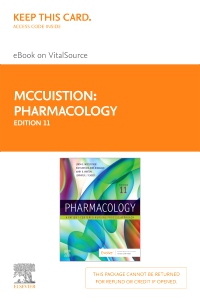
Pharmacology - Elsevier eBook on VitalSource (Retail Access Card), 11th Edition
Elsevier eBook on VitalSource - Access Card

Give your students a solid understanding of pharmacology and patient-centered nursing care! Pharmacology: A Patient-Centered Nursing Process Approach, 11th Edition makes it easy to learn the principles of pharmacology and drug dosage calculation. A clear guide to pharmacotherapy and safe drug administration, this book uses drug prototypes to provide need-to-know information about key drugs, including dosage, side effects, interactions, and more. Nursing Process summaries enhance your skills in clinical judgment and patient care. Written by a team of nursing experts led by Linda McCuistion, this text provides the pharmacology knowledge you need to succeed on the NCLEX® and as a professional nurse.
-
- NEW! Next Generation NCLEX® (NGN) examination-style case studies familiarize students to the way that content will be tested in the new NGN exam.
- NEW! Updated and clinically relevant drug content includes the latest drugs and drug therapies, and removes drugs no longer being used.
- NEW! Updated Nursing Process summary boxes in each chapter include the Clinical Judgment Model steps along with the nursing process.
- NEW! Additional Next Generation NCLEX case studies on the Evolve website address pharmacology, for instructor use in class and assignments.
- UNIQUE! Prototype Drug charts provide easy access to key information for representative drugs, including dosages, side effects, interactions, contraindications, pharmacokinetics, and more.
- UNIQUE! Extensive Drug Calculations chapter features a math review as well as step-by-step instructions for frequently used methods of dosage calculation.
- Critical Thinking case studies challenge students to apply their knowledge and analytical skills to realistic patient scenarios, and include answer guidelines on Evolve.
- UNIQUE! Nursing Process summaries highlight important nursing considerations related to drug therapy and emphasize patient teaching, patient safety, and relevant cultural content.
- Consistent RN-standard pedagogy includes chapter outlines and objectives, review questions, and learning resources on the Evolve website.
- Application-level NCLEX study questions include at least one alternate-style question per chapter, preparing students for the growing pharmacology coverage on the NCLEX Examination.
- Safety and Quality chapter discusses medication errors, specific nursing measures to promote safety, National Patient Safety Goals, and other safety issues and concerns.
- Prioritization coverage helps students learn to prioritize nursing care by listing nursing interventions in the order of priority, and a smaller font size differentiates between need-to-know and nice-to-know content.
- QSEN focus addresses competencies relating to Quality and Safety Education for Nurses.
-
- NEW! Next Generation NCLEX® (NGN) examination-style case studies familiarize you to the way that content will be tested in the new NGN exam.
- NEW! Updated and clinically relevant drug content includes the latest drugs and drug therapies, and removes drugs no longer being used.
- NEW! Updated Nursing Process summary boxes in each chapter include the Clinical Judgment Model steps along with the nursing process.
-
Unit 1: Introduction to Pharmacology
- The Nursing Process and Patient-Centered Care
- Drug Development and Ethical Considerations
- Pharmacokinetics and Pharmacodynamics
- Pharmacogenetics
- Complementary and Alternative Therapies
- Pediatric Considerations
- Geriatric Considerations
- Drugs in Substance Use Disorder
- Safety and Quality
- Drug Administration
- Drug Calculations
- Fluid Volume and Electrolytes
- Vitamin and Mineral Replacement
- Nutritional Support
- Adrenergic Agonists and Antagonists
- Cholinergic Agonists and Antagonists
- Stimulants
- Depressants
- Antiseizure Drugs
- Drugs for Parkinsonism and Alzheimer’s Disease
- Drugs for Neuromuscular Disorders and Muscle Spasms
- Antipsychotics and Anxiolytics
- Antidepressants and Mood Stabilizers
- Antiinflammatories
- Analgesics
- Antibacterials
- Antituberculars, Antifungals, and Antivirals
- Antimalarials, Anthelmintics, and Peptides
- HIV- and AIDS-Related Drugs
- Transplant Drugs
- Vaccines
- Anticancer Drugs
- Targeted Therapies to Treat Cancer
- Biologic Response Modifiers
- Upper Respiratory Disorders
- Lower Respiratory Disorders
- Cardiac Glycosides, Antianginals, and Antidysrhythmics
- Diuretics
- Antihypertensives
- Anticoagulants, Antiplatelets, and Thrombolytics
- Antihyperlipidemics and Drugs to Improve Peripheral Blood Flow
- Gastrointestinal Tract Disorders
- Antiulcer Drugs
- Eye and Ear Disorders
- Dermatologic Disorders
- Pituitary, Thyroid, Parathyroid, and Adrenal Disorders
- Antidiabetics
- Urinary Disorders
- Pregnancy and Preterm Labor
- Labor, Delivery, and Postpartum
- Neonatal and Newborn
- Reproductive Health
- Men’s Health and Reproductive Disorders
- Sexually Transmitted Infections
- Adult and Pediatric Emergency Drugs
Unit 2: Pharmacotherapy and Drug Administration
Unit 3: Maintenance of Homeostasis
Unit 4: Autonomic Nervous System Drugs
Unit 5: Central and Peripheral Nervous System Drugs
Unit 6: Mental and Behavioral Health Drugs
Unit 7: Pain and Inflammation Management Drugs
Unit 8: Antimicrobial Drugs
Unit 9: Immunologic Drugs
Unit 10: Antineoplastics and Biologic Response Modifiers
Unit 11: Respiratory Drugs
Unit 12: Cardiovascular Drugs
Unit 13: Gastrointestinal Drugs
Unit 14: Eye, Ear, and Skin Drugs
Unit 15: Endocrine Drugs
Unit 16: Renal and Urologic Drugs
Unit 17: Reproductive and Gender-Related Drugs
Unit 18: Sexually Transmitted Infections






 as described in our
as described in our 